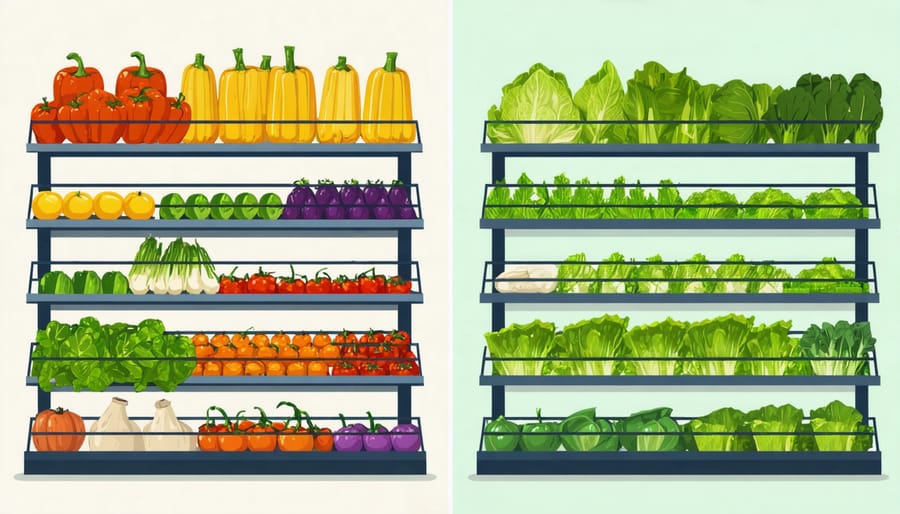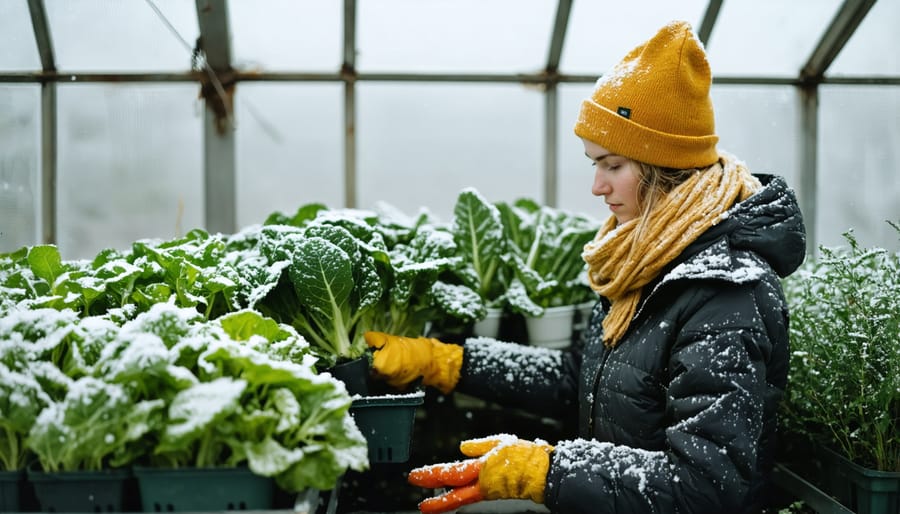Sustainable Greenhouse Gardening Slashes Your Food Bills (While Saving the Planet)

Sustainable gardening transforms your backyard into a thriving ecosystem while slashing your environmental footprint and grocery bills. By working in harmony with nature rather than against it, this mindful approach to cultivation creates a self-sustaining cycle that benefits both your garden and the planet. From water conservation through smart irrigation to soil enrichment using homemade compost, sustainable gardening practices offer practical solutions for today’s climate-conscious gardeners.
Growing your own food sustainably not only ensures fresh, chemical-free produce for your table but also reduces packaging waste and transportation emissions associated with store-bought vegetables. The methods are surprisingly simple: collecting rainwater, practicing companion planting, and maintaining healthy soil biology. These techniques create resilient gardens that require fewer inputs while producing abundant harvests year after year. Whether you’re a seasoned gardener or just starting out, embracing sustainable practices helps create a greener future while providing immediate rewards in the form of healthier plants, reduced maintenance costs, and improved biodiversity in your garden space.
Economic Benefits That Pay You Back
Reduced Grocery Expenses
Growing your own produce can significantly reduce your grocery expenses, especially as food prices continue to rise. When you maintain a sustainable garden, you’ll find yourself making fewer trips to the supermarket and spending less on fresh vegetables and herbs. A well-planned garden can yield hundreds of dollars worth of produce throughout the growing season, with many vegetables providing multiple harvests from a single planting.
Consider the cost of organic tomatoes at the store, often priced at $4-5 per pound. A single tomato plant, costing around $3-4, can produce 20-30 pounds of tomatoes over a season. Similar savings apply to leafy greens, herbs, and other vegetables. By starting plants from seeds, the cost savings become even more substantial.
The financial benefits extend beyond immediate grocery savings. You can preserve excess produce through canning, freezing, or dehydrating, creating a stockpile that lasts through the off-season. Additionally, you can save money by collecting and storing seeds from your plants for next year’s garden, eliminating the need to purchase new seedlings annually.

Lower Water Bills
One of the most compelling advantages of sustainable gardening is its significant impact on water consumption and utility bills. By implementing water-wise practices like mulching, drip irrigation, and rainwater harvesting, gardeners can reduce their water usage by up to 50%. Smart plant selection, focusing on drought-resistant varieties and native species, naturally requires less watering while maintaining a beautiful landscape.
Installing a simple rain barrel system can collect thousands of gallons of free water annually, while soil amendments like compost help retain moisture and reduce the need for frequent watering. Many sustainable gardeners report seeing their water bills drop by 30-40% after implementing these practices. Mulching alone can save up to 20 gallons of water per square foot each year by preventing evaporation.
The best part? These water-saving methods require minimal investment and maintenance while providing long-term financial benefits. Plus, reducing water consumption helps preserve local water resources and supports ecosystem health, making it a win-win for both your wallet and the environment.

Environmental Impact You Can See
Smaller Carbon Footprint
Sustainable gardening significantly reduces your carbon footprint in several meaningful ways. When you grow your own food, you eliminate the need for long-distance transportation of produce, which cuts down on fossil fuel emissions. Consider this: the average vegetable in a supermarket travels over 1,500 miles before reaching your plate. By growing your own, you’re directly contributing to lower transportation emissions.
The reduction in packaging waste is another substantial benefit. Home-grown produce doesn’t require plastic wrapping, styrofoam containers, or cardboard boxes that typically end up in landfills. By implementing energy-saving solutions in your garden setup, you can further minimize your environmental impact.
Additionally, sustainable gardening practices like composting and rainwater harvesting create a closed-loop system that reduces waste and conserves resources. Using natural pest control methods and organic fertilizers instead of chemical alternatives prevents harmful substances from entering the environment. This holistic approach to gardening not only provides fresh, healthy produce but also helps combat climate change at a grassroots level, making every garden a small but significant part of the solution.
Natural Resource Conservation
Sustainable gardening practices play a crucial role in preserving our precious natural resources, particularly water and soil. By implementing water-wise techniques like mulching, drip irrigation, and rainwater harvesting, sustainable gardens typically use 50-70% less water than conventional gardens. These methods not only reduce water consumption but also ensure that plants receive consistent moisture without wastage.
Soil health benefits tremendously from sustainable practices. Through composting and natural fertilization methods, gardeners build rich, living soil that retains moisture better and supports beneficial microorganisms. This improved soil structure reduces erosion, increases water retention, and naturally filters pollutants, creating a self-sustaining ecosystem in your garden.
The practice of crop rotation and companion planting helps maintain soil fertility naturally, reducing the need for synthetic fertilizers. These methods also promote better nutrient cycling and prevent soil depletion, ensuring your garden remains productive year after year. Additionally, sustainable gardens often incorporate native plants that are naturally adapted to local rainfall patterns and soil conditions, further reducing resource demands.
By choosing sustainable gardening methods, you’re not just growing plants – you’re actively participating in water conservation and soil preservation for future generations.
Year-Round Growing Success
Climate Control Benefits
Controlled growing environments offer gardeners unprecedented control over their plants’ development while supporting environmental sustainability. By utilizing sustainable storage solutions and climate control methods, you can create optimal conditions year-round, regardless of external weather patterns. This approach allows you to extend growing seasons, protect plants from extreme temperatures, and maintain ideal humidity levels for maximum yield.
A controlled environment helps reduce water consumption through efficient irrigation systems and moisture retention. You’ll use up to 70% less water compared to traditional outdoor gardening, as water can be recycled and reused within the system. Temperature regulation also means less energy waste, particularly when combined with proper insulation and solar-powered ventilation systems.
Moreover, climate-controlled spaces protect your plants from pests naturally, reducing the need for harmful pesticides. This creates a healthier growing environment and ensures your produce remains chemical-free. The ability to fine-tune growing conditions also means you can cultivate a wider variety of plants, including those not typically suited to your local climate, while maintaining eco-friendly practices.

Pest Management Made Easy
Managing pests in your greenhouse doesn’t have to mean reaching for harsh chemicals. Nature provides excellent solutions that work in harmony with your sustainable gardening practices. Start by introducing beneficial insects like ladybugs, praying mantises, and parasitic wasps – these natural predators keep harmful pest populations in check while maintaining the ecosystem’s balance.
Companion planting is another effective strategy. Plant aromatic herbs like basil, mint, and marigolds throughout your greenhouse. These not only repel unwanted insects but also attract pollinators and add beauty to your growing space. Create diverse plant communities that naturally support each other’s health and resilience.
Physical barriers and traps offer additional protection. Install fine mesh screens on vents and openings to prevent pest entry while maintaining good airflow. Yellow sticky traps can monitor and control flying insects, while diatomaceous earth provides a natural barrier against crawling pests.
Regular monitoring and maintaining optimal growing conditions are your best defenses. Healthy plants naturally resist pests, so focus on proper watering, ventilation, and spacing. This proactive approach helps prevent problems before they start, making pest management a natural part of your sustainable greenhouse routine.
Health and Wellness Rewards
Chemical-Free Growing
Growing without synthetic chemicals isn’t just better for the environment – it’s better for your garden and your family too. By embracing organic growing methods, you’ll create a thriving ecosystem where beneficial insects and microorganisms work together to naturally control pests and diseases. This balanced approach means healthier plants that are more resistant to problems in the first place.
Natural fertilizers like compost and worm castings release nutrients slowly, improving soil structure and promoting stronger root systems. Unlike chemical fertilizers, they won’t create dependency or burn your plants. Plus, you’ll have peace of mind knowing your homegrown vegetables and herbs are free from potentially harmful pesticide residues.
Chemical-free growing also protects important pollinators like bees and butterflies, which are essential for successful fruit and vegetable production. The absence of synthetic pesticides means beneficial insects can thrive, creating a self-regulating garden environment that becomes more resilient over time. As an added bonus, you’ll save money by making your own organic fertilizers and natural pest control solutions using common household ingredients.
Mental Health Benefits
Sustainable gardening offers remarkable mental health benefits that extend far beyond the simple joy of watching plants grow. The mindful practice of tending to your greenhouse garden can serve as a natural stress reliever, helping to lower cortisol levels and promote a sense of calm. Many gardeners report feeling more grounded and connected to nature while working with their plants, creating a peaceful escape from daily pressures.
The satisfaction of growing your own food and maintaining a sustainable garden can boost self-esteem and create a sense of accomplishment. Regular greenhouse gardening activities, such as watering, pruning, and harvesting, provide a gentle form of exercise while encouraging mindfulness and present-moment awareness. This combination of physical activity and mental focus can help reduce anxiety and improve overall mood.
Additionally, the greenhouse environment creates a year-round sanctuary where you can practice therapeutic gardening regardless of weather conditions. The consistent routine of caring for plants, observing their growth, and problem-solving challenges helps develop patience and resilience – valuable skills that transfer to other areas of life. Many gardeners find that their greenhouse becomes a meditation space, offering solitude and reflection time while nurturing both plants and personal well-being.
Sustainable gardening in your greenhouse offers a remarkable combination of benefits that extend far beyond your garden beds. From reducing your environmental footprint through water conservation and natural pest management to enjoying fresh, chemical-free produce year-round, the advantages are both immediate and long-lasting. By embracing sustainable practices, you’ll not only save money on utilities and supplies but also contribute to a healthier planet while creating a thriving ecosystem in your backyard. Whether you’re an experienced gardener or just starting out, taking the first step toward sustainable greenhouse gardening is easier than you might think. Start small, implement one eco-friendly practice at a time, and watch as your garden transforms into a productive, sustainable sanctuary that benefits both you and the environment. The journey to sustainable gardening begins with a single seed – why not plant yours today?

